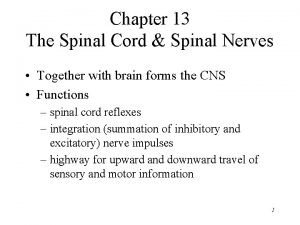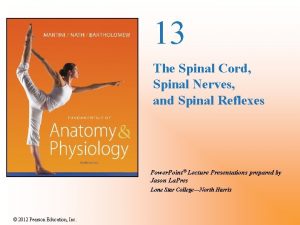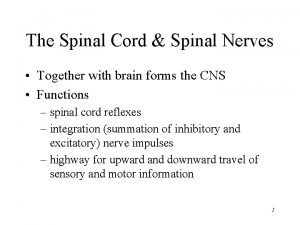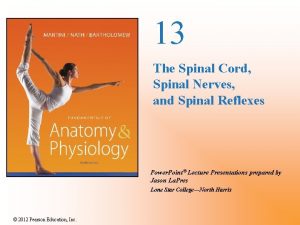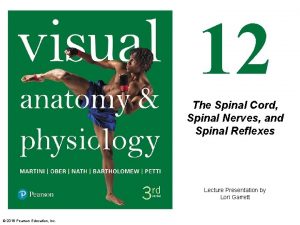The Spinal Cord and Spinal Nerves Spinal Cord









- Slides: 9

The Spinal Cord and Spinal Nerves

Spinal Cord • Location – Begins at the foramen magnum – Ends as conus medullaris at L 1 vertebra • Functions – Provides two-way communication to and from the brain – Contains spinal reflex centers

T 12 Ligamentum flavum Lumbar puncture needle entering subarachnoid space L 5 L 4 Supraspinous ligament Filum terminale L 5 S 1 Intervertebral disc Arachnoid matter Dura mater Cauda equina in subarachnoid space Figure 12. 30

Cervical enlargement Dura and arachnoid mater Lumbar enlargement Conus medullaris Cauda equina Filum terminale (a) The spinal cord and its nerve roots, with the bony vertebral arches removed. The dura mater and arachnoid mater are cut open and reflected laterally. Cervical spinal nerves Thoracic spinal nerves Lumbar spinal nerves Sacral spinal nerves Figure 12. 29 a

Spinal Cord • Spinal nerves – 31 pairs • Cervical and lumbar enlargements – The nerves serving the upper and lower limbs emerge here • Cauda equina – The collection of nerve roots at the inferior end of the vertebral canal

Spinal Cord • Gray matter – more centrally located; looks like a butterfly. Consists of nerve cell bodies and dendrites • White matter – surrounds the gray matter and is composed of white, myelinated fibers (axons) • Central canal – center of the gray matter; contains cerebrospinal fluid

Spinal Nerves • Formed from the posterior (dorsal) root and anterior (ventral) root • The posterior (dorsal) root carries sensory fibers • The anterior (ventral) root carries motor fibers • The posterior (dorsal) root ganglion consists of somatic sensory neuron cell bodies that are unipolar • A plexus is a braided network of the anterior branches from some spinal nerves (cervical, brachial, lumbar and sacral)

Dorsal median sulcus Dorsal funiculus White Ventral funiculus columns Lateral funiculus Dorsal root ganglion Gray commissure Dorsal horn Gray Ventral horn matter Lateral horn Spinal nerve Dorsal root (fans out into dorsal rootlets) Ventral root (derived from several ventral rootlets) Central canal Ventral median fissure Pia mater Arachnoid mater Spinal dura mater (b) The spinal cord and its meningeal coverings Figure 12. 31 b

Dorsal root (sensory) Dorsal root ganglion Dorsal horn (interneurons) Somatic sensory neuron Visceral motor neuron Somatic motor neuron Spinal nerve Ventral root (motor) Ventral horn (motor neurons) Interneurons receiving input from somatic sensory neurons Interneurons receiving input from visceral sensory neurons Visceral motor (autonomic) neurons Somatic motor neurons Figure 12. 32






